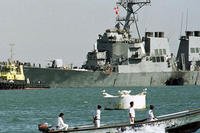The military uses a lot of unique terminology, some of which bleeds into the civilian world. Words like "bikini," "sideburns" and "head honcho" all got their beginnings in military service. Even phrases like "face the music" and "cut and run" came from the military.
For years and decades, service members have used common terms for gear and places that have just always been called what they're called. But even the names of these everyday aspects of military life had to evolve from some place in history.
Here are a few of those word origins.
1. Barracks
The word "barracks," used to describe where military personnel are housed, has two potential origins. The first dates back to the 1500s, when Spanish soldiers called their tents barraca, which is today the word for small shacks usually used by workers.
Another likely candidate is from the French region of Brittany. Until the 1530s, Brittany was semi-autonomous inside France, and Breton troops used to ridicule foreign soldiers for their foreign customs. Breton soldiers ate dark bread, while others ate whiter loaves. Bretons ridiculed them with the name baragouin, or "white bread." It quickly spread to England and on to Australia, where the word barracking is another name for "shouted criticism."

2. Boot Camp
"Boot camp" has always been a uniquely American term. It started its life in the 1890s for Navy and Marine Corps basic training facilities. This is also where the term "boot" to describe a new recruit originated, as new recruits wore new leather leggings during camp. "Boot camp" is simply a training camp for new "boots."
3. Camouflage
From the Italian verb camuffare, the word for concealing something by blending it into its surrounding, camouflage comes from slang used by French thieves. A camouflet, or "puff of smoke," was used by pickpockets who distracted marks with female accomplices. The women, called camouflette, would blow smoke in the mark's face, which was a sexual advance in the late 1800s.
By the 1910s, British military strategists began using the term "camouflage" to describe any means used to hide men and vehicles from enemy aircraft.
4. Canteen
In the mid-1800s, Italian troops were using the word cantina ("cellar") to describe their dispensaries, which doled out basic needs, booze and cigarettes. Pretty soon, troops began socializing at the cantinas, which expanded to a more communal meeting area where they would drink their purchases.
It wasn't long before the name was attached to the bottles they used to carry water, because the troops were filling the bottles with products purchased from the cantina.

5. Carbine
Someone has to remove the dead from the battlefields. On the Italian peninsula, the princes in power often hired people to do it. They were called scarabinni, after the Scarab Dung Beetle who performed a similar job in nature. The rifles they used were modified so they could fire their weapons in combat on horseback more effectively. These were known as carabiniere.
In English, the word became "carbine" and is still used to describe any long rifle that has been made more compact.
6. Chevrons
The shape of a chevron comes from the shapes of French rooftops, called "chevre," because they were in the shape of two goats ready to fight it out. Almost as if they were cloud formations, two different kinds of people saw two different things. When the British military adopted it for non-commissioned officer ranks, they saw a knight's lance broken in a duel.
7. Grenade
Hand-thrown incendiaries date back for centuries, first being used by the Byzantines and carrying a payload of the mysterious Greek fire. Grenades as we call them first appeared in Europe in 1467,with payloads of black powder and cast iron stuffed into a projectile the size of a pomegranate.
It turns out that these were fairly apt names for the weapon, as it was very similar to the size, shape and "seeds" inside the explosive devices. By 1590, the French word for "pomegranate," grenade, became the word for it.
8. Jeep
The word "jeep" existed before World War II and was used to describe fresh recruits or new equipment during World War I. Anything that was unproven, goofy or foolish was often described as "jeepy."
In 1936, E.C. Segar published his comic strip "Popeye," which featured the now-famous sailor man with an animal pet: Eugene the Jeep. The ultimate storytelling tool, Eugene the Jeep could do almost anything and solve almost any problem. The ability to go anywhere and do anything meant that U.S. troops were using "jeep" to describe almost any all-terrain vehicle. It stuck with the Willys MB Quarter-Ton Vehicle, what we know as a WWII Jeep today.

9. Point Blank
We use this term to describe a range of fire that is very close to its target. It's actually derived from Middle Ages France when archers used a target that featured a white bull's-eye, called point blanc. If the archer was close enough, all he had to do was point the arrow at the white and let fly.
10. Target
Archers in England, centuries after the Middle Ages, called their shooting practice bull's-eye a "butt" (because the British have a different word for everything). Meanwhile, a targe was a round, wooden shield used by Scottish highlanders. When firearms were adopted by armies of the times, the wooden shields were abandoned and stacked in armories.
With a new weapon to perfect and plenty of small, wooden objects to shoot at now taking up space, troops began using the shields as "targets. "
-- Blake Stilwell can be reached at blake.stilwell@military.com. He can also be found on Twitter @blakestilwell or on Facebook.
Want to Learn More About Military Life?
Whether you're thinking of joining the military, looking for post-military careers or keeping up with military life and benefits, Military.com has you covered. Subscribe to Military.com to have military news, updates and resources delivered directly to your inbox.
















